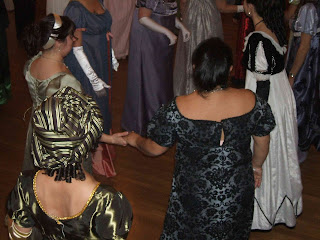One of the most beloved writers of romance is back…. She’s better than ever, and she’s worth the wait! Her wit is laugh-out-loud funny and her poignant moments are so heartwarming. I’m glad she is back, and I do believe she is better than before and I know, like me, all her fans will be saying her new book was worth the long wait!
 A big Riskies welcome to Laura Kinsale, who is here to chat about her new release Lessons in French. She’s offered a signed copy to one person who makes a comment or asks a question. So come on in and chat!
A big Riskies welcome to Laura Kinsale, who is here to chat about her new release Lessons in French. She’s offered a signed copy to one person who makes a comment or asks a question. So come on in and chat!
RR: Welcome, Laura, it’s great to have you visit. Let’s jump straight into the interview: What’s your favorite part of writing?
LK: That deep sense of flow and concentration, when I’m living in the story with the characters. It doesn’t come on demand, but when it does, it makes it all worth doing.
RR: What do you think the key to writing comedy is?
LK: Putting an unexpected twist at the end of a sentence or paragraph.
 RR: If Lessons in French were made into a movie, who would play the leads (can be any actors at any time; mix and match, if you want)?
RR: If Lessons in French were made into a movie, who would play the leads (can be any actors at any time; mix and match, if you want)?
LK: I’m a fan of USA’s White Collar at the moment. Matt Bomer would be perfect for Trev, just that sense of devil-may-care elegance and mischief.
 Callie, hmmm–maybe a very young Julie Andrews.
Callie, hmmm–maybe a very young Julie Andrews.
RR: Why do you love Heyer so much? What is your favorite book?
LK: My favorite Heyer is Sylvester, for the hero’s intense low moment and grovel. I love Heyer’s dry wit, mixed with a little craziness. It’s hard to top the Baluchistan hound in Frederica for finely-tuned character comedy.
RR: What’s your favorite part about Twitter? What’s the funnest experience you’ve had there?
 LK: I secretly enjoy tweeting animals. My dog Ventoux (who tweets as me, oddly enough!) has a couple of particular friends, a great dane, @dooleybug8 and a horse in New Zealand, @stationbred . They keep life in perspective, tweeting back and forth about visits to the vet, opening gates, and how to get under Mom’s skin.
LK: I secretly enjoy tweeting animals. My dog Ventoux (who tweets as me, oddly enough!) has a couple of particular friends, a great dane, @dooleybug8 and a horse in New Zealand, @stationbred . They keep life in perspective, tweeting back and forth about visits to the vet, opening gates, and how to get under Mom’s skin.
RR: (Aaaaw) (And the standard Risky question) What’s “risky” about Lessons in French?
LK: From a writing standpoint, the conflict. Callie and Trev are in love from the start, thought they don’t admit it to themselves, much less to one another. So the things that keep them apart have to be something the reader can comprehend as real obstacles that are true to the characters. I had to be very convincing in developing the characters, their beliefs about themselves and the world, because it’s largely those self-concepts that drive the conflict. That’s a fairly difficult writing challenge. But worth it. Readers seem to really like both the hero and heroine.
Thanks for having me on the Riskies!
Your question or comment? Ask away …


















